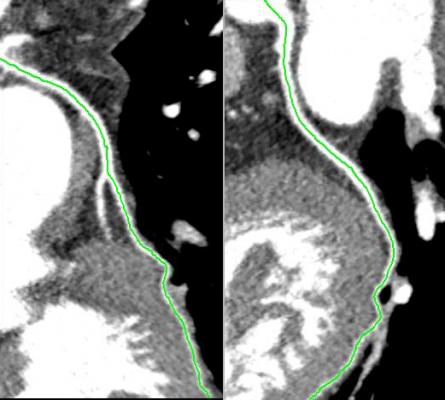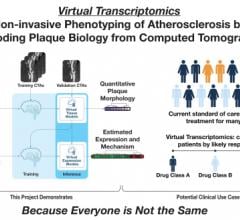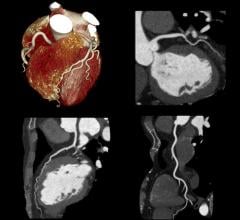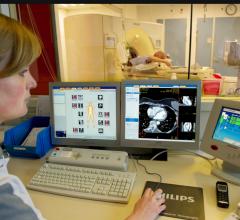
March 16, 2015 — Results from the PROMISE clinical trial confirmed what many cardiologists and radiologists have long suspected to be true: Coronary computed tomographic angiography (coronary CTA) is extraordinarily effective in accurately diagnosing patients with low to moderate chest pain. In most cases, coronary CTA is at least as effective as diagnostic methods such as stress tests such as SPECT myocardial perfusion imaging. The results were presented at the American College of Cardiology (ACC) 2015 Annual Scientific Sessions in San Diego.
The PROMISE trial is the first-ever randomized controlled trial to compare clinical outcomes in patients receiving functional stress testing or computed tomographic angiography to check for signs of cardiovascular disease. It also provides the first data to inform clinical guidelines on the use of these tests, according to the authors.
The study included a total of 10,003 patients who visited 193 health centers in the United States and Canada. Participants had no prior diagnosis of coronary artery disease but had new symptoms that made physicians suspect they might have heart disease. Nearly all had at least one cardiovascular risk factor such as high blood pressure, diabetes or a history of smoking.
Half were randomly selected to receive a CTA, which generates 3-D images of the heart’s arteries that doctors can use to assess the degree of narrowing. The rest received a functional test — either an exercise electrocardiogram (ECG), stress echocardiography or nuclear stress test — which are used to track the heart’s response to stress using electrical signals, sound waves or imaging. All of these tests have been in common use for a decade or more but functional tests and CT scans have never before been compared head-to-head in terms of clinical outcomes.
The study showed no differences between patients receiving a CTA and those receiving functional heart tests in terms of the study’s primary endpoint, a composite rate of death, heart attack, major procedural complications or hospitalization for chest pain. At least one of these outcomes occurred in roughly 3 percent of patients in both groups during more than two years of follow-up.
However, some secondary endpoints, including the level of radiation exposure and the rate of subsequent procedures that did not reveal significant heart disease, favored CT angiography.
Authors said these results are important because current clinical guidelines leave the selection of tests for patients reporting symptoms such as chest pain or shortness of breath, which constitutes at least 4 million patients in the United States each year. Currently, selection is largely up to physician and patient preference.
Society of Cardiovascular Computed Tomography (SCCT) President Ricardo C. Cury, M.D., FSCCT, observed that these findings demonstrate that coronary CTA plays a critical role in enabling physicians to determine and plan the best course of action in treating the millions of persons annually who present with low to moderate chest pain. Cury noted, "Today's findings from PROMISE show that coronary CTA is a viable alternative to functional stress testing to assess symptomatic, intermediate risk patients for whom testing is currently recommended. As a matter of fact, an initial strategy with CTA was associated with a significant lower rate of invasive catheterization without obstructive CAD (28 percent) as compared to a functional strategy with stress test that demonstrated 52 percent of invasive catheterization without obstructive CAD. This study should significantly impact daily clinical practice, with the potential to dramatically reduce the number of unnecessary invasive angiograms, stress tests and other resource-intensive procedures."
“Until this study, we have essentially been guessing on decisions about which initial test to use for this huge population of patients who need evaluation for cardiovascular symptoms,” said Pamela Douglas, M.D., the Ursula Geller Professorship for Research in Cardiovascular Diseases at Duke University and the study’s lead author. “Our study shows that the prognostic outcomes are excellent and are similar regardless of what type of test you use, but there are some indications that computed tomographic angiography might be the safer test with fewer catheterizations without obstructive disease and lower radiation exposure when compared to nuclear testing.”
A key strength of the study is that it offers a reflection of current medical practice, rather than an idealized view.
“Unlike most trials where medical care is very tightly controlled, this study was designed to represent real world care,” Douglas said. “The health centers that collected the data were responsible for interpreting the tests and doing appropriate patient follow-up. Because this was such a community-based, real-world setting, the study really tells us a lot about clinical practice and how patients are being cared for in the U.S. now.”
The 3 percent rate of death, heart attack, major procedural complications or hospitalization for chest pain seen in both groups was lower than expected, especially considering the fact that most study participants had two or more significant heart disease risk factors, were middle aged or older and symptomatic. The relative benefit of CT angiography compared to functional testing held steady across different patient subgroups as defined by age, gender, race and cardiovascular risk factors. Although there was a significantly lower rate of death and non-fatal heart attacks after one year of follow-up in patients receiving a heart CT scan, for reasons that are unclear, this difference was not sustained in the second year, study authors said.
“The event rate in itself is intriguing, because no previous studies have closely tracked and adjudicated the rate of adverse events in this patient population,” Douglas said. “These outcomes are so good given widespread use of medications like statins and aspirin. It does raise the question of whether we can identify a group of people who actually do not need to be tested.”
After their initial non-invasive test, about 10 percent of study participants underwent at least one cardiac catheterization procedure, a more invasive procedure in which an interventional cardiologist threads a catheter into the heart through an artery to assess narrowing in the arteries and, if needed, open the arteries with a balloon or stent. The rates of patients undergoing catheterization that failed to identify substantial narrowing were significantly higher in the patients receiving functional testing, at 4.3 percent, compared to 3.4 percent in the patients who had received a CT scan.
In addition, at three months patients receiving heart scans received significantly lower radiation exposure than patients who were given a nuclear stress test as their first diagnostic test.
Douglas said the bottom line for patients is that if the primary concern is avoiding serious adverse heart problems such as death, heart attack or hospitalization, heart CT scans and functional tests are both excellent options. For lower-priority concerns such as avoiding subsequent tests and procedures or avoiding radiation exposure, heart CT scans appear to be a slightly better option.
Douglas said the team plans to further investigate outcomes for different subgroups of patients to determine whether different groups might benefit from different testing approaches.
The research team also analyzed the financial implications of the data in terms of medical costs and reimbursements, which will be presented separately.
President-Elect Jonathon A. Leipsic, M.D., FSCCT, added that the impact of this study may go well beyond initial evaluation of the presenting patient, by helping physicians recommend the most appropriate long-term care for their patients. "These results are very exciting," Leipsic stressed. "PROMISE affirms our experience in clinical practice, notably the apparent benefit of medical therapy on those uniquely identified by coronary CTA to have non-obstructive atherosclerosis. PROMISE appears to demonstrate that coronary CTA uniquely identifies a patients who have non-obstructive atherosclerosis and who will benefit from medical therapy. Interestingly, there was also a significant early benefit of the CTA strategy over functional imaging for decreasing hard events (death or non-fatal myocardial infarction) in 12 months. This is extremely impactful data."
Coronary CTA is an imaging method that uses a CT scanner to non-invasively and painlessly examine the structure and blood vessels of the heart. While this technology has been in use for many years elsewhere in the body, recent advances in CT scanners now enable highly trained physicians and technologists to take and interpret three-dimensional images of the beating heart with extraordinary clarity and detail. With these recent advances, a coronary CTA now can replace the need for an exercise stress test or an invasive cardiac catheterization and angiogram.
The study was funded by the National Heart, Lung and Blood Institute of the National Institutes of Health (NIH).
Related content on CT Perfusion imaging:
Watch a VIDEO on CT perfusion advances from SCCT 2015.
Advances in CT Perfusion Imaging
New Technology Supports CT as Prime Cardiac Imaging Modality
PROMISE Trial Shows CT is as Effective as Stress Tests and SPECT to Assess Chest Pain
For more information: www.scct.org, acc.org


 March 07, 2024
March 07, 2024 








